INDONESIAN TZSUNAMI Kills at Least 86 on JAVA ISLAND, hardest hit: PANGANDARAN and nearby CILACAP after EARTHQUAKE 7.2

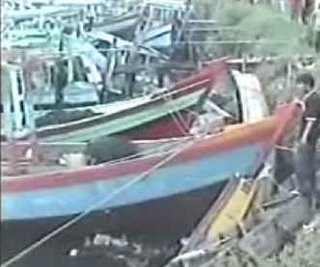

 Above: The destruction of the beaches and the debris after the Tzunami
Above: The destruction of the beaches and the debris after the TzunamiBelow: The destruction wrecked on the buildings in the coastal towns


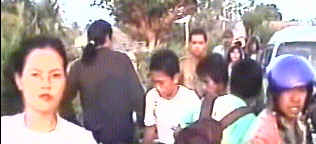

Update 2 Jul 19 , 2.30 am
Deat toll risen to 339; and 601 or more still missing
Worst hit area Pangandaran beach - 181 killed, 85 still missing
and in Cilacap, 89 killed and more than 70 missing.
Most of those killed are local Indonesians, but a Pakistani and a Swedish nationals and 3 Dutchmen were also reported killed
and from
Deutsche Presse-Agentur; Java tsunami death toll increases
Tuesday, 18 July 2006, 13:28 GMT
The death toll from a tsunami that struck the Indonesian island of Java has risen to at least 339, health ministry officials say. Another 136 people are reported missing around Pangandaran, the worst-hit area.
The tsunami was triggered by a 7.7 magnitude undersea earthquake that struck off Pangandaran on Monday afternoon, causing a 2m-high wave. Indonesian troops have arrived to help with the search for the missing and assist the hundreds of injured.
At first light, rescuers were confronted with the sight of bodies in the branches of trees, and in the rubble of smashed hotels and houses. Boats and cars were washed inshore by the water and the streets were littered with debris.
______________________________________
I saw enormous waves engulf our beach and sweep away cars and boats. - Eyewitness Elan Jayalani
______________________________________
Survivors spoke of a wall of water and a loud roar.
"When the waves came, I heard people screaming and then I heard something like a plane about to crash nearby, and I just ran," Uli Sutarli, a plantation worker who was on Pangandaran beach, told Reuters news agency.
A Belgian tourist said he was in a beachside bar when the wave hit. "I saw this big cloud of dark sea water coming up to me," he said.
Missing
In addition to the dead, about 450 people have been injured and around 52,700 people have been displaced, a spokesman for Indonesia's health ministry told the French news agency AFP.
Hospitals were said to be packed with the injured seeking treatment and people searching for their relatives.
Body bags and other essential items have begun to arrive, and relief aid such as tents and food are being sent for the thousands of people who have fled their homes.
The UN's World Food Programme said it was sending 15 metric tons of noodles and high-energy biscuits to the survivors.
A number of foreign nationals were believed to be among the injured.
Sweden's foreign ministry said two Swedish children from a family on holiday
in the area were believed to be missing.
Exact figures for the numbers of dead are contradictory, but Vice President Jusuf Kalla said the toll was expected to rise in coming days.
Warning
Rumours that another tsunami was about to hit had people fleeing their homes in the early hours of Tuesday.
______________________________________
By Achmad Sukarsono
JAKARTA (Reuters) - Lack of funds has crippled the creation of a tsunami warning system, leaving earthquake-prone Indonesia without a single working detection buoy, an official said on Tuesday, a day after a tsunami killed over 270 people.
No sirens alerted residents in Pangandaran beach the worst-hit area of Monday's tsunami, after a 7.7 magnitude quake struck 180 km (112 miles) offshore in the Indian Ocean.
Edi Prihantoro, an official at Indonesia's Ministry of Research and Technology that oversees a national warning project, told Reuters the southern Java area had no system to warn people of coming waves.
Indonesia deployed two tsunami buoys last year off Sumatra island, part of a five-year project to install similar detectors all around the world's largest archipelago. But when asked how many of them were operational, Prihantoro said: "None."
"We need at least 22 buoys to cover all of Indonesia. We have received two from Germany and they were deployed months ago. However, both of them are damaged now," he said.
Both have since been removed from the sea and one of the damaged buoys is sitting in a warehouse in west Sumatra awaiting repairs.
Geneva - Early warning systems worked well in alerting people to the earthquake and tsunami which struck the island of Java on Monday, according to UN officials.
'The early warning functioned well and was issued in time to warn Nicoba Island and even Australia,' said a spokesperson for the Office for Co-ordination of Humanitarian Affairs, OCHA. 'The response had been very quick,' she added.
However, the Indonesian Red Cross reported that local people had fled after being alerted by the cries of neighbours.
'We felt the earthquake and then later we saw families moving away from the sea, screaming tsunami, tsunami,' said Pak Limin. He fled his home in one of the worst hit areas at Pangandaran in West Java with his daughter in search of safer ground.
Stockpiled supplies left over from international appeals for the December 2004 Tsunami in Indonesia would be used, OCHA confirmed. UN staff on the spot had been mobilised and the response had been very quick.
At least 245 people are thought to have died, according to local officials, when waves two metres high swept inland triggered by the 7.7 magnitude earthquake.
The figure may still change as rescuers work their way through the debris. Up to 40 000 may have been forced to leave their homes though many were now returning. Around 60 per cent of the population was thought to be in need of help.
**********************************************
Update 1 July 18 06: as of 6pm local time, the Indonesian Health Ministry has announced the death toll as 327 people killed (with at least 4 foreigners) , 430 injured in the southern and central part of Java island. 150 persons are still missing and 52,700 people have been displaced by the surging Tzunami waters
and from ABC (Australia Broadcasting Corp)
Update: Tuesday, July 18, 2006. 7:34pm (AEST)
Devastating tsunami ... at least 300 now feared dead.
Devastating tsunami ... at least 300 now feared dead. (AFP)
Australia survivor tells of 5-metre tsunami
Australian survivors of a devastating tsunami on Java's south coast say that up to six waves struck the area yesterday.
At least 300 people are now feared dead and many remain missing.
Indonesia's health ministry crisis centre says that Swedish, Japanese, Dutch and Saudia Arabians are among the hundreds wounded by the tsunami.
Australian survivor Graham Mulligan was today sifting through the rubble of his bay surf shop in Batu Keras, west of Pangandaran.
"The first we knew of the tsunami was a roar," he said.
Adding that he and his surfing mates watched as fishing boats were thrown into the air in the bay, which is a popular surfing spot for Australian tourists.
Mr Mulligan said there were about six waves, the second was the biggest, about four or five metres high, he said.
The surf shop businessmen say they will not leave but are committed to rebuilding.
No tsunami warning system buoys were in place when an undersea earthquake caused the massive waves to strike the coast.
Seismologists say that because the undersea earthquake was not as powerful and covered a smaller physical area than 2004's Boxing Day's tsunami, the triggered waves did not have the same destructive force.
But survivors are wondering why a proposed tsunami early warning system was not in place along Java's coast, given it is as vulnerable to undersea earthquakes as the island of Sumatra, where Indonesian authorities say two early tsunami warning buoys are now in place.
Assistance
Foreign Affairs Minister Alexander Downer says Australia has sent two representatives to Indonesia to assess what might be done to help victims of the tsunami.
Mr Downer says an Australian Defence Force officer and an AusAid staffer are heading to the affected area.
Mr Downer says Australia has also raised concerns with Indonesian authorities about rumours that some prisoners with links to the Bali bombings were caught up in the tsunami.
"So far they have not been able to either confirm or deny any of the rumours," Mr Downer said.
"That's not to say that three Bali bombers have been drowned or have been affected by the tsunami, we simply just do not know at this stage and we're endeavouring to find out."
REPORT from AP
By IRWAN FIRDAUS; The Associated Press
PANGANDARAN,
As darkness fell at least 30 bodies were piled up at one clinic near the coast, including several children covered in white sheets, and thousands of terrified residents set up camp in the hills overlooking the sea.
Regional agencies issued bulletins Monday saying a 7.7-magnitude earthquake that struck 150 miles off
The hardest-hit area appeared to be Pangandaran, an idyllic beach resort on the southern coast popular with local and foreign tourists. People shouted "Tsunami! Tsunami!" as the more than 6-foot-high wave approached, some climbing trees or crowding into inland mosques to pray, witnesses said.
Boats crashed to shore, some slamming into hotels, and houses and restaurants were flattened along a 110-mile stretch of the densely populated island's southern coast.
Jan Boeken, from
"I looked back at the beach and saw a big wall of thundering black water coming toward us," said the 53-year-old, who escaped with minor cuts to the head and knees. "I ran, but I got trapped in the kitchen, I couldn't get out. I got hit in the body by debris and my lungs filled with water."
The Indonesian Red Cross, police and district officials said at least 82 people were killed and 77 others were unaccounted for, most in Pangandaran and nearby Cilacap. El-Shinta radio reported four other deaths.
"We are still evacuating areas and cross-checking data," Red Cross official Arifin Muhadi told The Associated Press.
Most of the victims were believed to be Indonesians, but at least one Swedish tourist was being treated for injuries at a hospital near Pangandaran and his two sons, 5 and 10, were missing, said Jan Janonius, a Swedish Foreign Ministry spokesman.
A witness told el-Shinta he saw the ocean withdraw 1,500 feet from the beach a half-hour before the powerful wave smashed ashore, a typical phenomenon before a tsunami.
"I could see fish jumping around on the ocean floor," Miswan said. "Later I saw a wave like a black wall."
Local media reports said the wave came as far 900 feet inland in some places. Buildings sit close to the beach in Pangandaran.
Pedi Mulyadi, a 43-year-old food vendor, said he was waiting on the beach for customers when the wave struck, killing his wife, Ratini, 33. The pair were clinging to one another when they were swallowed by the torrent of water and pulled 300 feet inland, he said.
"Then we were hit, I think by a piece of wood," Mulyadi said. "When the water finally pulled away, she was dead. Oh my God, my wife is gone, just like that."
Roads were blocked and power cut to much of the area. Damage and casualties were reported at several places along the 110 miles of beach affected, officials and media reports said.
"All the houses are destroyed along the beach," one woman, Teti, told el-Shinta radio. "Small hotels are destroyed and at least one restaurant was washed away."
Java was hit seven weeks ago by a 6.3-magnitude earthquake that killed more than 5,800 people, but was spared by the 2004 tsunami that killed 216,000 people, nearly half of them in
The May earthquake did not affect the part of the island hit by Monday's tsunami, which was spawned by a quake that struck deep beneath the
The quake struck at
After the quake, the
see also last post...
see latest post (Jul 24 06)
INDONESIA EARTHQUAKE (Jul 23 06) - 6.6 - Sparks TZUNAMI Scare; CHINA EARTHQUAKE (Jul 22 06) 5.1 Struck SW Yunnan Province; Death Toll Risen to 22
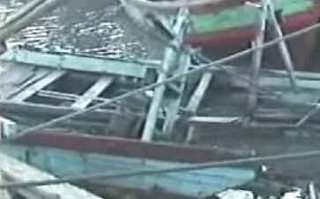
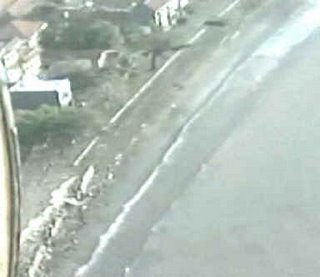
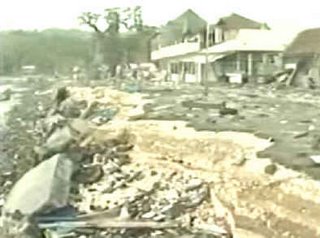

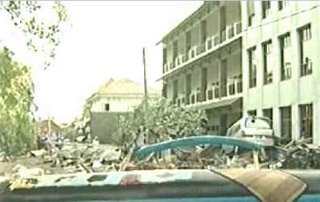
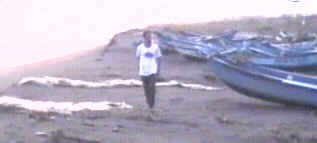





0 Comments:
Post a Comment
<< Home